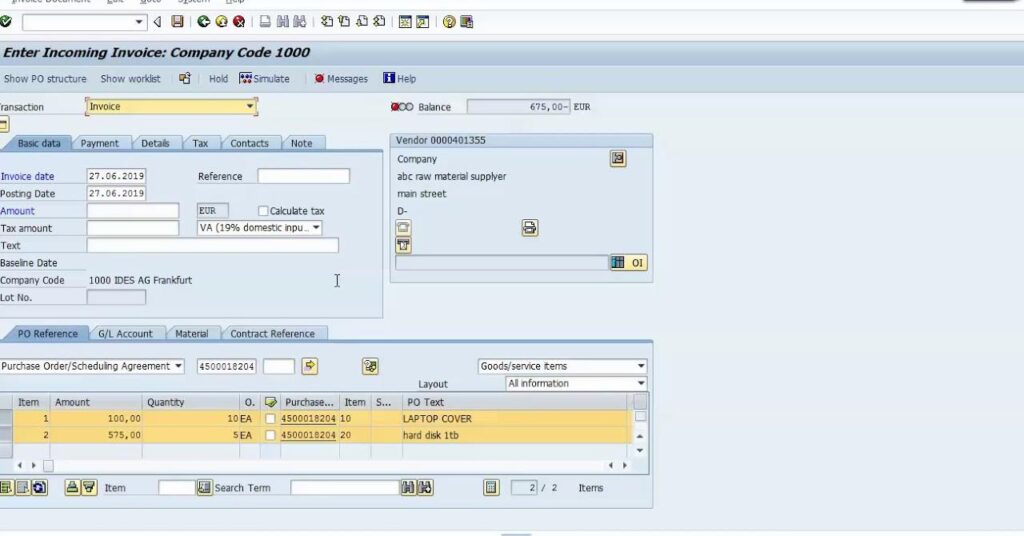Are you curious to know what is MIRO in SAP? You have come to the right place as I am going to tell you everything about MIRO in SAP in a very simple explanation. Without further discussion let’s begin to know what is MIRO in SAP?
In today’s digital era, businesses are constantly seeking ways to optimize their operations and improve efficiency. SAP (Systems, Applications, and Products) is a leading enterprise resource planning (ERP) software that offers a wide range of modules to support various business functions. One important module within SAP is MIRO (MIRO – Enter Incoming Invoice), which focuses on streamlining the invoice processing workflow. In this blog post, we will delve into what MIRO is in SAP, its functionality, and its significance in simplifying and automating the accounts payable process.
What Is MIRO In SAP?
MIRO is a transaction code in SAP that stands for “MIRO – Enter Incoming Invoice.” It is a module within SAP’s Materials Management (MM) component, specifically designed to manage and process incoming vendor invoices. MIRO enables businesses to automate and streamline the accounts payable process, from invoice creation and validation to approval and payment.
Functionality And Benefits Of MIRO
- Invoice Creation and Entry: MIRO allows users to create and enter incoming vendor invoices into the SAP system. The module provides a user-friendly interface, where relevant invoice details, such as vendor information, invoice number, date, and line item details, can be entered accurately.
- Validation and Matching: MIRO performs crucial validation checks to ensure accuracy and consistency in invoice data. It validates the vendor details, checks for duplicate invoices, verifies the purchase order (PO) and goods receipt (GR) information, and matches the invoice with the corresponding PO and GR data.
- Approval Workflow: MIRO facilitates the setup of an approval workflow for invoice processing. Users can define approval rules and hierarchies based on organizational requirements. The system automatically routes the invoice to the appropriate approvers for review and approval, ensuring a smooth and controlled workflow.
- Integration with Financial Accounting: MIRO seamlessly integrates with the Financial Accounting (FI) module within SAP, allowing for efficient tracking and posting of invoice data. The module updates relevant financial accounts, such as accounts payable and general ledger accounts, ensuring accurate and up-to-date financial records.
- Payment Processing: Once the invoice is approved, MIRO enables the generation of payment documents and initiates the payment process. It integrates with SAP’s payment management functionality, enabling businesses to manage payment terms, track payment status, and maintain a comprehensive payment history.
Significance In Business Processes
The MIRO module in SAP offers several benefits to organizations:
- Enhanced Efficiency: By automating the invoice processing workflow, MIRO reduces manual effort, eliminates paper-based processes, and minimizes the risk of errors or duplicate payments. It accelerates the overall invoice processing cycle and improves efficiency in the accounts payable function.
- Improved Accuracy and Control: MIRO’s validation checks and matching capabilities ensure that invoice data is accurate and aligned with purchase orders and goods receipts. This reduces the likelihood of discrepancies and improves financial control and compliance.
- Streamlined Approval Process: The configurable approval workflow in MIRO enables businesses to establish efficient approval hierarchies and routes invoices to the appropriate stakeholders. This streamlines the approval process, expedites decision-making, and enhances transparency and accountability.
- Real-time Insights: MIRO provides real-time visibility into invoice statuses, payment schedules, and financial data. Organizations can access comprehensive reports and analytics, enabling better cash flow management, forecasting, and decision-making.
Conclusion
MIRO in SAP is a powerful module that revolutionizes the invoice processing workflow within organizations. By automating invoice creation, validation, approval, and payment processes, MIRO streamlines the accounts payable function, enhances efficiency, and improves financial control. With its seamless integration with other SAP modules, MIRO provides real-time visibility and insights into invoice data and financial records. Embracing MIRO in SAP empowers businesses to optimize their operations, reduce manual effort, and focus on strategic financial management. As organizations embrace digital transformation, MIRO proves to be a valuable tool in achieving streamlined and efficient invoice processing within the SAP ecosystem.
FAQ
What Is MIRO In SAP Used For?
MIRO is a transaction code used for Enter Incoming Invoice in SAP.
What Is The Full Form Of MIRO?
MIRO : movement in receipt out MIGO : movement in goods out.
What Is The T Code MIRO In SAP?
The SAP TCode MIRO is used for the task : Enter Incoming Invoice. The TCode belongs to the MRM package.
What Is The Difference Between MIRO And Fb60 In SAP?
FB60- When u purchase the goods / services with or without PO, to book the purchase or expenses and giving credit to vendor this TCOD is to be use. 2. MIRO- When material or services recived and debited in respective purchase or expenses account but not credited to vendor.
I Have Covered All The Following Queries And Topics In The Above Article
What Is MIRO And Migo In SAP
What Is Migo And MIRO In SAP
What Is MIRO In SAP Mm
What Is The Difference Between Migo And MIRO In SAP
What Is Migo In SAP
MIRO In SAP Full Form
MIRO Process In SAP Pdf
MIRO SAP Tcode
How To Do MIRO In SAP
What Is MIRO And Migo In SAP
Migo In SAP Full Form
SAP MIRO Process Flow
What Is MIRO In SAP
What is difference between Migo and Miro
What is Miro in SAP mm?






